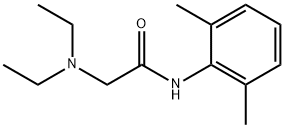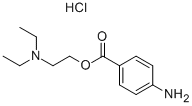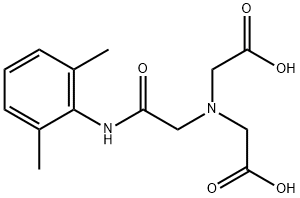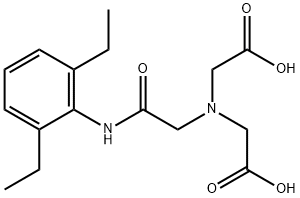Lidocaine , ≥99% , 137-58-6
Synonym(s):
2-Diethylamino-N-(2,6-dimethylphenyl)acetamide;Lignocaine;Xylocaine
CAS NO.:137-58-6
Empirical Formula: C14H22N2O
Molecular Weight: 234.34
MDL number: MFCD08443609
EINECS: 205-302-8
| Pack Size | Price | Stock | Quantity |
| 5G | RMB40.80 | In Stock |
|
| 25G | RMB112.80 | In Stock |
|
| 100G | RMB293.60 | In Stock |
|
| 500g | RMB1222.40 | In Stock |
|
| others | Enquire |
PRODUCT Properties
| Melting point: | 66-69°C |
| Boiling point: | bp4 180-182°; bp2 159-160° |
| Density | 0.9944 (rough estimate) |
| refractive index | 1.5110 (estimate) |
| Flash point: | 9℃ |
| storage temp. | Store at RT |
| solubility | ethanol: 4 mg/mL |
| pka | pKa 7.88(H2O)(Approximate) |
| form | powder |
| color | White to slightly yellow |
| Water Solubility | practically insoluble |
| Merck | 14,5482 |
| BCS Class | 1 |
| Stability: | Stable. Incompatible with strong oxidizing agents. |
| InChIKey | NNJVILVZKWQKPM-UHFFFAOYSA-N |
| LogP | 2.440 |
| CAS DataBase Reference | 137-58-6(CAS DataBase Reference) |
| NIST Chemistry Reference | Lidocaine(137-58-6) |
| EPA Substance Registry System | Acetamide, 2-(diethylamino)-N-(2,6-dimethylphenyl)- (137-58-6) |
Description and Uses
Lidocaine [2-(diethylamino)-N-(2, 6-dimethylphenyl) acetamide monohydrochloride] is the most
commonly used amino amide-type local anesthetic. Lidocaine is very lipid soluble and, thus, has
a more rapid onset and a longer duration of action than most amino ester-type local anesthetics,
such as procaine and tetracaine. It can be administered parenterally (with or without epinephrine)
or topically either by itself or in combination with prilocaine or etidocaine as a eutectic mixture
that is very popular with pediatric patients. The use of lidocaine–epinephrine mixtures should be
avoided, however, in areas with limited vascular supply to prevent tissue necrosis. Lidocaine also
frequently is used as a class IB antiarrhythmic agent for the treatment of ventricular arrhythmias,
both because it binds and inhibits sodium channels in the cardiac muscle and because of its
longer duration of action than amino ester-type local anesthetics.
Central nervous system changes are the most frequently observed systemic toxicities of
lidocaine. The initial manifestations are restlessness, vertigo, tinnitus, slurred speech, and
eventually, seizures. Subsequent manifestations include CNS depression with a cessation of
convulsions and the onset of unconsciousness and respiratory depression or cardiac arrest. This
biphasic effect occurs because local anesthetics initially block the inhibitory GABAergic
pathways, resulting in stimulation, and eventually block both inhibitory and excitatory pathways (i.e., block the sodium channels associated with the NMDA receptors, resulting in overall CNS inhibition).
Lidocaine is used in creams and lotions to soothe areas of inflamed skin or for example in hemorrhoid preparations to reduce discomfort; used by doctors to anesthetise areas prior to surgery, often avoiding the need for a general anesthetie; used by injection after a heart attack to treat some rhythm disturbances.
Safety
| Symbol(GHS) |  GHS07 |
| Signal word | Warning |
| Hazard statements | H302 |
| Precautionary statements | P301+P312+P330 |
| Hazard Codes | Xn,T,F |
| Risk Statements | 22-39/23/24/25-23/24/25-11 |
| Safety Statements | 22-26-36-45-36/37-16-7 |
| RIDADR | 3249 |
| WGK Germany | 3 |
| RTECS | AN7525000 |
| HazardClass | 6.1(b) |
| PackingGroup | III |
| HS Code | 29242990 |
| Hazardous Substances Data | 137-58-6(Hazardous Substances Data) |
| Toxicity | LD50 oral in rat: 317mg/kg |





